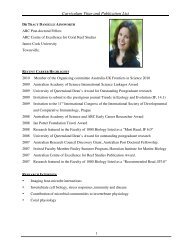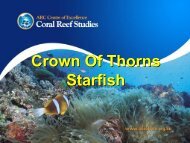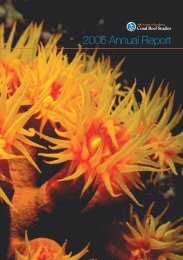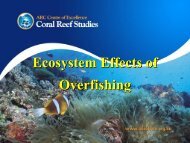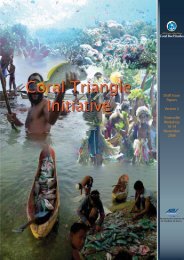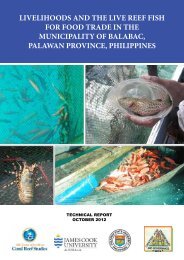Teacher's Guide
Teacher's Guide
Teacher's Guide
Create successful ePaper yourself
Turn your PDF publications into a flip-book with our unique Google optimized e-Paper software.
environmental education plan for lihir (eepl) booklets 1–4Teacher’s <strong>Guide</strong>Booklets 1–4EnvironmentalImpacts ofMining on LihirResource book forUpper Primary andLower Secondary > >This booklet guides teachers toeffectively use the four EEPL resourcebooklets to help students understandthe environmental impacts of miningusing the Lihir example as a case study
environmenntal education plan for lihir (EEPL) developed byScientific conceptsEEPL Booklets 1–4solwara research and m squared design in consultation with the curriculum development division national department of education, png @ 2007dvd
Resource book forUpper Primary andLower SecondaryDirect EnvironmentalImpacts of Mining at Lihir > >Teacher’s <strong>Guide</strong>EEPL Booklets 1–4Developed by Solwara ResearchSponsored by Lihir Gold Limited
upper primary teacher’s guide environmental education plan for lihirDeveloped byDr Martha Macintyre and Dr Simon Foaleof Solwara Research withMouli MacKenzie of M Squared Design inconsultation withThe Curriculum Development Division of theNational Department of EducationPapua New GuineaIllustrations and animations for DVDdeveloped in conjunction with Paul Huskinson,Shane McKenzie and the 2006 Multi Mediastudents, Design Department, CanberraInstitute of TechnologyCartoons by Bob BrowneGrass Roots Comic Company, NCD, PNGFunded by Lihir Gold LimitedPrinted by Nexus Printing2007
IntroductionThis guide is designed to help Upper Primary and LowerSecondary teachers to make the most effective classroomuse of the four EEPL student resource booklets, to teachPapua New Guinean school children about the environmentalimpacts of extractive industries in their country. EEPL standsfor Environmental Education Plan for Lihir. These four bookletswere designed by a team of science and social scienceresearchers together with an education materials developerand staff of the Curriculum Development Division, in responseto a number of important concerns raised by the people of Lihirabout the environmental impacts of the gold mine on theirenvironment. Some of these concerns, as the booklets reveal,were well founded, and others were not. In the majority of cases,the people of Lihir were more concerned than they needed to be.The project was funded by Lihir Gold Limited.The EEPL booklets were developed originally for the people ofLihir, but have broader national value for teachers and studentsall over PNG. Mining is an increasingly common industry in thecountry, and most Papua New Guinean students are aware ofthe large mining operations, past and present, and the fact thatsome of them have had significant environmental impacts. Someof the environmental problems that are indirect effects of mining— such as accelerated population growth and migration whichresult in increased land pressure and soil degradation — arealso happening in many places where there is no mining, and areincreasingly relevant all over the country. Teachers outside NewIreland Province, are recommended to use Lihir as a case study,and then discuss any similar impacts in their specific region.Mining also frequently generates significant social impacts,such as increased inequality, disruption of family life, increasesin alcohol consumption and violence, and collapse of traditionalauthority, but these issues are beyond the scope of this material.
upper primary teacher’s guide environmental education plan for lihirSome explanation of the Lihir context is necessary.There are two main reasons for the production of these booklets.Firstly, there has been a widespread belief on Lihir that ‘acidrain’ from the mine has been responsible for a decline in fertilityof gardens (Booklets 1 and 2 show that this is not true). Onecommonly-asked question on Lihir was, ‘Is the smoke from themine causing acid rain that is damaging Lihirian gardens?’ Theseand other questions are relevant to other mining communitiesin PNG. The four booklets express the concerns of the Lihiriancommunity as questions like this, and then answer the questionsby clearly communicating the scientific principles behindenvironmental impacts such as acid rain, acid rock drainage, andland degradation due to population pressure.Secondly, when the mine closes, there will be a sudden andsevere reduction in the amount of money on the island, and mostpeople, including those who are currently buying the bulk of theirfood with money, are going to have to return to producing muchof their food from gardening. Since the mine was constructed,there has been a steady loss of gardening knowledge, as peoplehave become increasingly dependent on money, and spentless and less time growing food. It is important that the richknowledge of gardening on Lihir (and elsewhere in PNG), most ofwhich is unwritten, is not lost as a result of this process. Booklet 4is both a contribution to the preservation of that knowledge, andan exploration of the intersection between traditional gardeningknowledge and modern agricultural science.The booklets can be used for Grade 6 (if talked through by theteacher) and independently from Grade 7 through to Grade 10and above. The material contained in the booklets includes bothrelatively simple explanations as well as more complex ones foreach scientific principle that relates to the environmental issue inquestion. In general the top panel of the booklets, with the largertype and white background, contains the simpler explanations,and the bottom coloured panels contain the more detailed
introductionexplanations that are more suitable for older students andextension studies. The information is extremely student-friendly,with pictures and diagrams which reinforce the adjacent textsmaintaining student interest. Each booklet has a glossary forunfamiliar and scientific terms (these terms are all bolded in thetext). Teachers may like to use the booklets in an English classfirst, to familiarise students with new vocabulary, before usingthem in science and social science curriculum. Each bookletends with a list of self-check questions to ensure students haveunderstood the concepts in the booklets.Because some of the environmental impacts are quitecomplex, and can also be the subject of debates and disputesbetween land-owners, mining companies, governments andnon-government organizations, it is important that the futureleaders of PNG are as well informed as possible about scientificunderstandings of the environmental impacts of mining.This Teacher’s <strong>Guide</strong> provides an effective reference to using theEEPL booklets by 1) indicating the sections of the Upper Primaryand Lower Secondary Syllabus that each booklet relates to, and2) providing suggestions for learning activities relevant to eachcomponent of the booklets.The learning activities are organised by booklet. Each activityis preceded by a list of equipment and materials needed, sothat teachers can quickly find which activities they will be ableto teach, based on what they have available. In most casesthe equipment needed for the learning investigations andexperiments is readily available, even in remote locations.The activities follow the Predict-Observe-Explain strategyoutlined in the Lower Secondary Teacher <strong>Guide</strong>. Where applicable,teachers should also encourage students to follow the four stepprocedure on page 11 of the Lower Secondary Teacher <strong>Guide</strong>:1) Plan the investigation, 2) Conduct the investigation,3) Process the data / results, 4) Evaluate the investigation.
upper primary teacher’s guide environmental education plan for lihirIntroductory activities1. The location of LihirThe location of Lihir is shown on Map 1 below.As an initial activity, get the students to find Lihir in their atlases.LihirMahur IslandPNGlihir group of islandsMasahet IslandLondolovitMalie IslandLadolamPutputNiolam IslandPalieThe Lihir gold mine at LadolamMap 1The location of Lihir in PNG, and theislands in the Lihir Group. The mine islocated at Ladolam and the processingplant at Putput.
introductory comparative activities2. The location of mining operations throughout PNGAsk the students to find the locations of other miningoperations in PNG in their atlases, plus any new miningoperations that they may know about.What other extractive industries in other regions of PNGmay have similar environmental impacts?Lorengauò SimberiVanimoWewakKaviengó Lihir? Finished mines exploration operations, which are not shown.Rabaulò Freidaó Ok TediTabubilMt Kare òMadangò Ramuò Sinivit˚ KainantuLaeWafi òHamata ò˚Tolukumaò WoodlarkPort òLajokiMoresbyò ImwaunaAlotau? Misimakeyó Large scale mine˚ Medium scale mineò Possible mineMap 2The location of operating, finished and possiblemines in PNG. There are several gas and oil minesaround Lake Kutubu. There are many other miningó Porgera Bougainville ?
upper primary teacher’s guide environmental education plan for lihir3. Comparative materialAsk the students to find photographs of other mining operationsin PNG, at Misima, Porgera, Ok Tedi, Bougainville, Tolukuma,and Kutubu.What other extractive industries may have similar environmentalimpacts?
introductory comparative activitiesBackground informationOther mining operations in PNGProduction figures (in tonnes) for the existing mineral mines inPNG for the period 2003 to 2005 are as follows:MineGold2005The data inthis table wasprovided by thePNG Chamberof Mines andPetroleumGold2004Gold2003Silver2005Silver2004Silver2003> In 2005 the four gold mines in PNG plus the alluvial minersproduced just over 68 tonnes of gold.> Minerals make up 49.4% of PNG’s export revenue.> Production in 2006 is estimated to be over 70 tonnes.> PNG has three out of the six top gold producing mines inAustralasia.> The mine at Kainantu owned by Highlands Pacific, whichstarted production in 2006, forecast to be producing115,000 ounces of gold per year by the end of 2006.= 3.243 tonnes; 1 ounce = 28.2 gramsCopper2005Copper2004> Production data for the year 2005 for the various oil and gasprojects around Lake Kutubu are as follows:• Kutubu oil: 5.1 million barrels• Gobe oil: 0.85 million barrels• Moran oil: 3.64 million barrels• Mananda oil: no data at time of writing• Hides gas: 5.426 billion cubic feet1 barrel = 158.99 litres, or 0.15899 cubic metres35.55 cubic ft = 1 cubic meter; 1 cubic ft = 28.32 litresCopper2003Ok Tedi 17.85 16.3 16.0 40.984 36.1 34.5 192,978 173,370 201,300Porgera 26.996 31.7 26.5 4.906 7.5 5.1Misima 1.6 3.7 6.8 16.8Lihir 18.538 18.6 17.1Tolukuma 2.374 2.67 2.5 5.235 5.2 5.5small scale 2.7 2.8 2.2Total 68.483 73.67 68.0 51.125 55.6 61.9 192,978 173,370 201,300
10 upper primary teacher’s guide environmental education plan for lihirBackground information30 mw geothermal power station at Lihir mine siteStages in producing electricity from volcanic steamSteam — vented all over the mine siteis now used to produce electricitySilencers — reducesnoise level of escapingwater and steamWell head — bringssteam and water fromhundreds of metresunderground to supplythe power plantSeperator — removes water,supplies good clean steam todrive the steam turbineSteam turbine and generator— Steam turns steamturbine, turbine turns thegenerator to produce power— power plant
ackground information 11Cooling tower — cools hot waterand supplies cooling water tocondenser and to rest of the plantGas removal system —removes non condensablegas from condenser anddischarges it at top ofcooling towerCondenser — cools steam from theturbine, condenses it to water, andpumps the hot water to the coolingtower, increasing the turbine efficiencycycle and doubling the power supplyElectricity — for Lihir plant operations
12 upper primary teacher’s guide environmental education plan for lihirBooklet 1 The cloud cycle and acid rainIntroductionThe key concepts in Booklet 1: Cloud cycle and acid rain that lendthemselves to experimentation are evaporation and condensation.Some of the themes in Booklet 1 are revisited in Booklet 2: Smokeand Steam, most importantly the relationships between steam,water vapour and condensation (see pages 22–25).Booklet 1 helps students to understand the relationship betweensteam, water vapour, humidity and rain. Booklet 1 also coversthe formation of acid rain, but the key concepts relating toacidity and pH, including the measurement of the pH of rain, arecovered in detail in the activities relating to Booklet 3(see pages 26–32).Relevant learning outcomes for Booklet 1Upper PrimaryLower Secondary7.1.1, 8.1.1 — Working scientifically7.3.1, 8.3.1 — Learning about substances7.3.2 — Explaining physical and chemical changes in matterusing simple experiments9.1.5 — Indigenous (local) knowledge and practices9.3.1, 9.3.2 — Ecology9.5.1, 9.5.2, 9.5.3 — Atoms and the periodic table9.7.1, 9.7.2, 9.7.3 — Earth and atmosphere10.1.1, 10.1.2 — Working scientifically through projects andinvestigations10.3.1, 10.3.2, 10.3.3 — Chemical reactions
ooklet 1: cloud cycle and acid rain 13Suggested learning activitiesEvaporation and condensation can be investigated in many ways.1. Measuring evaporationGrades 7–8; Outcomes: 7.1.1, 7.3.1, 7.3.2, 8.1.1, 8.3.1Tools and materials required> a measuring flask. If this is not available, the experiment canstill be done with a glass or plastic container.> another glass, metal or plastic container with a large opening,such a large jar or a bucket — the volume of this containermust be larger than the one used for measuring.Procedure to demonstrate evaporationAssessment1. Precisely measure (to the nearest milliliter if possible) anamount of water using a measuring flask from the laboratory.At the same time, place exactly the same amount of waterin another similar or same kind of container, but with a lid orsome kind of close-fitting covering.If you do not have a measuring flask, fill some othercontainer such as a plastic water bottle right to the very topand use this as your measure.2. Leave the water in both the open and closed containers in theclassroom for one or two days.3. Get the students to measure and compare the amount ofwater left in both containers at the end of this period.The volume of water in the closed container should not havechanged significantly, while the amount of water in the opencontainer should have reduced measurably.Get the students to explain what happened to the water in theopen container.
14 upper primary teacher’s guide environmental education plan for lihir2. Demonstrating condensation, part 1Grades 7–8; Outcomes: 7.1.1, 7.3.1, 8.1.1, 8.3.1Tools and materials requiredProcedureAssessment> a clear plastic or glass soft-drink bottle, with screw-on lidHalf fill a clear plastic soft-drink bottle with water, put the lidback on, and leave the bottle in the sun for a few hours. At theend of this period, you will observe many drops of water thathave condensed on the inside of the top half of the container.Get the students to observe the container carefully at thebeginning and at the end of the experiment, and get them toexplain the changes they observe.Condensation on acold bottle of water
ooklet 1: cloud cycle and acid rain 153. Demonstrating condensation, part 2Grade 8; Outcomes: 8.1.1, 8.3.1Tools and materials requiredProcedureAssessment> a refrigerator> any glass container such as a beer or soft-drink bottle.The experiment will work better if the bottle is fullRefill empty bottles with water if you do not have anyunopened bottles.> a clean dry cloth or paper towel or tissue1. Leave the full bottle in the refrigerator for a few hours untilit is cold, and then take it out. Immediately wipe the outsideof the bottle with a cloth or paper towel to make sure it iscompletely dry.2. Leave the bottle at room temperature for a few minutes andobserve water droplets that form on the outside of the bottle.Ask the students where the water has come from.Explain that it is the drop in temperature that causes thewater vapour in the warm air to condense on the outside ofthe cold bottle to form the water droplets.
16 upper primary teacher’s guide environmental education plan for lihir4. Demonstrating condensation by building a stillGrades 8–10; Outcomes: 8.1.1, 8.3.1, 9.5.1, 10.1.1, 10.3.1Tools and materials requiredProcedure> a large cooking pot with a tight-fitting lid that has a knob inthe centre that can be removed> about two meters of flexible plastic tubing — the tubing mustbe the right diameter to fit tightly inside the hole in the centreof the pot lid> two other containers — wide-mouth jars or any plasticequivalent1. Half-fill the cooking pot with water.2. Remove the knob from the centre of the lid of the pot andinsert the plastic tubing into this. Make sure it is a tight fit.3. Place the other end of the tubing in another empty containerto collect the condensate.4. Make a few coils in the tubing, between the pot and thecontainer, and immerse them in a jar or another pot ofcold water. Keep this higher than the point at which thecondensate is to be collected.This step will make the condensing more effective, but ifyou are unable to secure the coils of the tube in a pot of coldwater the experiment will still work.5. Some condensate will form eventually at room temperature,but you will get results much more quickly if you heat thepot to increase the rate of evaporation and accumulation ofcondensate through the still.Use thcomparison with the increase in condensate throughheating to remind the students that evaporation is higher inwarm places.
ooklet 1: cloud cycle and acid rain 17^AssessmentGet the students to observe and explain the process.Setting up a stillThey should understand that the greater the heat appliedto the water in the pot, the higher the energy state of themolecules, and the larger the number of molecules that willmove from liquid to gas phase (evaporation). When theseevaporated molecules then come into contact with the coolertubing, they condense back to the liquid phase.Get the students also to taste the water that drains out of thestill. What if seawater is put in the pot? (You could try this asanother experiment). Is the water that comes out of the otherend of the still also salty? Get the students to explain theirfindings.Stills are also used to concentrate alcohol from fermentedvegetable matter — a common practice around the world,including in many Papua New Guinean villages. Get the studentsto explain why alcohol and water both evaporate relatively easily,but salts do not. What is the boiling point of ethanol? Methanol?
18 upper primary teacher’s guide environmental education plan for lihir5. Temperature and evaporationGrades 7–9; Outcomes: 7.1.1, 7.3.1, 7.3.2, 8.1.1, 9.7.2Tools and materials requiredProcedureAssessment> two clear plastic or glass bottles, with lids> a thermometer (not vital, but useful)1. A simple way to demonstrate the influence of temperatureon evaporation would be to repeat the experiment on page12, but this time take two soft-drink bottles and half-fill eachof them with water (don’t worry about measuring the waterthis time). Put the lids on both bottles.2. Place one of the bottles outside in the sun, and leave theother one inside the classroom, in the shade.This experiment may only need one hour to show results, butmight take longer.At the end of the period, compare the amount of condensationon the inside of each bottle — there should be more waterdroplets on the inside of the bottle that was left in the sun thanthe one in the class-room.If a thermometer is available, measure the temperature of thewater in each container at the end of the experiment.Get the students to explain why higher temperature causesgreater rates of evaporation.Exercise 1 for Booklet 2 also works with the issues ofsteam, water vapour, humidity, condensation and the energystates of the various forms of water. See pages 23–24.
ooklet 1: cloud cycle and acid rain 196. The effect of surface area on rate of evaporationGrades 8–9; Outcomes: 8.1.1, 8.3.1, 9.7.2, 9.7.3Tools and materials requiredProcedureAssessment> two plastic or glass bottles of identical size> a large bucket or cooking pot> a funnelThis experiment demonstrates the effect of surface area on therate of evaporation.In general, the greater the surface area of a body of waterthat is exposed to the air, the greater the rate of evaporation,all other things being equal.1. Fill the first of the two identical bottles with water and tip thecontents into a big cooking pot.2. Fill the second identical bottle to the top and place it and thecooking pot in the sun for a day. Leave the lid off the bottle.3. At the end of the day tip the water in the cooking pot backinto its water bottle. Compare the level of water in the twobottles.The first water bottle should have more water remainingbecause it has a smaller evaporative surface than the pot. Getthe students to think about how much water evaporates fromthe surface of the ocean every day. Where does this water go?
20 upper primary teacher’s guide environmental education plan for lihir7. Cloud formationGrades 6–7If possible, take the students to a location where they can viewhigh islands or mountains to observe whether they have cloudsforming above them.Cloud formation is often observed as a result of humidair over the ocean colliding with islands and beingforced upwards into layers of the atmosphere where thetemperature is lower, causing condensation of the watervapour into droplets that form clouds and rain.Many Pacific Islanders used to use clouds as a sign of land whenvoyaging at sea, because the clouds are usually visible fromgreater distances than islands. Most islands are usually relativelycloud free in the early morning, and clouds usually build upduring the course of the day — ask the students to explain this.
ooklet 1: cloud cycle and acid rain 218. Is there acid rain in your area?Grades 9–10; Outcomes: 9.1.5, 9.3.1, 9.3.2, 9.7.1, 9.7.2, 9.7.3,10.1.1, 10.1.2, 10.3.1, 10.3.2, 10.3.3Tools and materials requiredProcedureAssessment> litmus paper or a pH meter> access to a creek or riverGo to a river or creek near your school, one that you knowis not affected by land-based sources of pollution suchas the mine site, or the dumping of waste. Collect somewater in a clean jar and measure the pH with litmus paperor a pH meter. Repeat the test for at least three differentsamples of water and note the results for each sample.If the average pH of the samples is lower than 5.0 thenit is possible that it has been affected by some sort ofpollution, including the pollution that causes acid rain.Remember that pure, unpolluted rainwater has a pHof around 5.6.Ask the students why some people might think there isacid rain on Lihir.
22 upper primary teacher’s guide environmental education plan for lihirBooklet 2 Smoke and steamIntroductionBooklet 2: Smoke and steam has links to Booklet 1: Cloud cycle and acidrain, particularly the material on steam and condensation. Smokeis treated together with steam because some people appear not todistinguish between them, referring to both as ‘smoke’. The conceptsin Booklet 2 also explain much about the unique geology of LihirIsland, particularly the volcanically active material in Luise Caldera,which generates large amounts of steam — steam which used to bereleased through large pipes installed by the mining operation. Thesteam is generated by thermal energy emanating from the earth’smolten mantle, which is unusually close to the earth’s surfaceat Lihir. This energy is now being harnessed on Lihir to generateelectricity through a geothermal power plant (see pp 10–11).Relevant learning outcomes for Booklet 2Upper Primary6.1.1, 7.1.1, 8.1.1 — Working scientifically6.3.1, 7.3.1, 8.3.1 — Learning about substances6.3.2, 7.3.2 — Explaining physical and chemical changes inmatter using simple experiments6.3.3, 7.3.3, 8.3.3 — Understanding energy in its different forms6.4.1, 8.4.1 —Earth’s structure, and the formation of igneous andmetamorphic rocksLower Secondary9.1.5 — Indigenous (local) knowledge and practices9.5.1, 9.5.2, 9.5.3 — Atoms and the periodic table9.7.1, 9.7.2, 9.7.3 — Earth and atmosphere10.1.1, 10.1.2 — Working scientifically through projects andinvestigations
ooklet 2: smoke and steam 23Suggested learning activitiesThis exerciseis similar toseveral of theexercises forBooklet 1, whichdemonstratecondensation.Refer to theseif you havealready donethem.1. Observing steamGrades 7–8; Outcomes: 7.3.1, 7.3.3, 8.3.1, 8.3.3Tools and materials requiredProcedureAssessment> a kettle with water in it> a source of heat sufficient to boil the water> a piece of black cardboard or paper> a cold smooth hard object like a pen, metal plate or bottle1. Boil water in a kettle using a hot fire, and after the water hasstarted to boil actively, place a piece of black cardboard orplastic next to the side of the spout to make it easier for thestudents to see the steam coming from the spout.Observe the point at which the steam becomes visible.This is where the process of condensation is transforming thegaseous steam to tiny droplets which make it visible. Individualwater molecules, separated from each other by the very highenergy they acquire when heated to 100°C are cooling, losingtheir energy, and as a result starting to stick together as tinydroplets which become visible as white ‘steam’.2. Hold an object with a smooth, hard surface (e.g. a bottle,a plastic container, a pencil) in the steam plume for a fewseconds. Examine the surface of the object — it shouldhave many small droplets of water on it. Ask the students toexplain how the water got there.Get the students to give accurate definitions of a) steam,b) water vapour, c) humidity and d) condensation. Get themto explain the energy states of the various forms of water(liquid, gas, solid), as well as the changes in energy involved intransformation between liquid to gas and back again.
24 upper primary teacher’s guide environmental education plan for lihir2. Understanding dilutionGrades 7–8; Outcomes: 7.3.1, 8.3.1)Tools and materials requiredProcedureAssessment> an accurate means of measuring the volume of liquids inmilliliters, such as a graduated cylinder> a glass dropper or container that can measure small volumesto the nearest milliliter> food or clothing dye, or any other water-soluble colouredsubstance or natural plant dyes, in liquid formIf dye is available initially as a powder, dissolve a goodamount in a spoonful of water first> five clean jars, beakers or cups made of clear glass or plastic1. Drop two milliliters of liquid dye or colouring into a jar orbeaker with 98 milliliters of water and stir it so it is wellmixed. Get students to calculate the concentration of thedye in solution, as a percent (2%) or proportion (0.02) of theoriginal concentration of the dye.2. Now drop two milliliters of this solution into a secondjar containing 98 milliliters of pure water. Calculate theconcentration of the dye now.2% of 2% = 0.04%; proportion: 0.02 x 0.02 = 0.00043. Repeat the exercise another three times. Each time ask thestudents to recalculate the concentration of the dye.3 0.0008%; 4 0.000016%; 5 0.00000032%This is the basis of dilution.Discuss the similarities between this process and what happensto smoke as it disperses away from its source. Discuss therelative harm to human health posed by smoke from a distantpower generator with smoke inhaled from a cigarette, a kitchenfire, or a vehicle exhaust.
ooklet 2: smoke and steam 25Discussion points3. Steam generation at LihirGrades 7–8; Outcomes: 6.3.1, 6.3.3, 7.3.1, 7.3.3, 8.3.1, 8.3.3Discuss the processes involved in the generation of the steamat Lihir. Where does the heat come from to produce the steam?Where does the water come from? Is the steam pure water orare there other substances / chemicals in it?This should include a discussion of the nature of volcanoesand the geology of the Lihir group of islands.4. Smoke is made of particlesGrades 7–8; Outcomes: 6.3.1, 6.3.3, 7.3.1, 7.3.3, 8.3.1Get the students to discuss why the rafters and the undersurfaceof the roof of most village kitchens are black.The black substance is soot particles which comes from thesmoke from kitchen fires.Discuss: What is this substance? What might the inside of thelungs of a smoker look like?5. Smoke and sorceryGrades 9–10; Outcomes: 9.1.5, 10.1.1, 10.1.2Why do people sometimes use smoke as a means oftransmitting magic in gardens? Discuss. Why is smoke oftenused in sorcery?6. Smoke and dustGrades 7–9; Outcomes: 6.3.1, 7.3.1, 8.3.1, 9.1.5, 9.7.1, 9.7.2, 9.7.3What is the difference between smoke and dust? Why dopeople worry about dust?
26 upper primary teacher’s guide environmental education plan for lihirBooklet 3 Acids and acid rock drainageIntroductionThe word ‘acid’ is often used to signify anything corrosive oreven poisonous. In Booklet 3: Acids and acid rock drainage, thedifference between acid and corrosive is made clear, and thenature of acids, and their opposites, bases, is explained.Understanding this material requires some knowledge ofchemistry, and is likely to be easier to explain to older students.The key concepts of this booklet will be best demonstrated withequipment that can measure changes in pH.Relevant learning outcomes for Booklet 3Upper PrimaryLower Secondary6.1.1, 7.1.1, 8.1.1 — Working scientifically7.3.1, 8.3.1 — Learning about substances7.3.2, 8.3.2 — Investigate physical and chemical changes, andidentify and collect basic and acidic substances found innature9.2.1 — Working scientifically9.4.1, 9.4.2 — Our body9.5.3 — Atoms and the periodic table
ooklet 3: acids and acid rock drainage 27Suggested learning activitiesActivity 1 is useful to teachers in remote areas with no accessto litmus paper. Activities 2 to 4 teach students the differencebetween the meaning of ’acid’ and the meaning of ‘corrosive’.1. Noni roots as a pH indicatorGrades 6–8; Outcomes: 6.1.1, 7.1.1, 7.3.1, 7.3.2, 8.1.1, 8.3.1, 8.3.2Tools and materials requiredProcedure> some roots from a Noni tree (Morinda citrifolia)> colaAssessment> lime juice> battery acid Take care obtaining this!> bleach> powdered lime (kambang)> detergent> containers in which to place all of the above substancesUse the roots of the Noni tree (Morinda citrifolia) as a pHindicator. Try testing various common acids and bases.Try cola, lime (muli) juice, battery acid, bleach, dissolved lime(kambang) powder, detergent.Noni roots turn yellow when exposed to acids, and red whenexposed to bases.
28 upper primary teacher’s guide environmental education plan for lihir2. The meaning of ‘corrosive’, part 1Grades 7–9; Outcomes: 7.1.1, 7.3.1, 8.1.1, 9.2.1, 9.5.3Tools and materials requiredProcedureAssessment> glass or cup of Coca-cola or Pepsi-cola> a glass or cup of lemon or lime juice> a glass or cup of vinegar> a glass or cup of water and detergent (any kind)> a pH meter or litmus paper or noni roots> toea coins> soft cloth or paper towel1. In each of four glasses or cups place the following:1) Coca-Cola or Pepsi-cola, 2) lemon or lime juice, 3) vinegar,4) water with a generous amount of detergent.2. If a pH meter or litmus paper is available, measure the pH ofthe liquid in each glass. Make sure the glasses are labelled.3. Place a 1 or 2 toea coin in each glass and leave it overnight(best done between consecutive science classes).4. Remove the coin from each glass at the end of theexperiment, with a spoon.5. Now rub each coin with a soft cloth or paper towel.The coins from the cola, the lime juice and the vinegar should be‘clean’, i.e. shiny, while the coin from the detergent is unchanged.The acids from each of the first three liquids remove themetal oxides (‘rust’) from the surface of the coin. Colacontains phosphoric acid, lemon or lime juice containscitric acid, and vinegar contains acetic acid. Detergent is abase, so the corrosive reaction does not occur. The reactionbetween the acids and the copper oxide is a reductionreaction in which the hydrogen ions in the acid split the metaloxide bond, binding with the oxygen to form water (H 2O),and releasing metal ions (e.g. Cu + ).
ooklet 3: acids and acid rock drainage 293. Demonstrating the meaning of corrosive, part 2Grades 7–9; Outcomes: 7.1.1, 7.3.1, 8.1.1, 9.2.1, 9.5.3Tools and materials requiredProcedureAssessment> a glass eye-dropper or pipette> a small volume of battery acid> an old piece of cloth or clothing that is no longer needed> pH meter or litmus paper, or noni roots1. Obtain a small volume of battery acid by extracting it with adropper or pipette from a car or truck battery.Battery acid is extremely acidic and very corrosive.Exercise great care in handling this acid!2. Measure the pH of the battery acid with litmus paper or a pHmeter. It should be around pH 1 or lower.3. Pour the battery acid onto the piece of cloth that is no longerneeded, and leave it for a few days.The acid will burn a hole in the cloth. The damage will becomemore evident after washing the cloth in water.
30 upper primary teacher’s guide environmental education plan for lihir4. Demonstrating the meaning of corrosive, Part 3.Grades 7–9; Outcomes: 7.1.1, 7.3.1, 8.1.1, 9.2.1, 9.4.1, 9.4.2, 9.5.3Tools and materials requiredProcedureAssessment> lime (kambang) powder> a glass of water> pH meter or litmus paper1. Dissolve a generous amount (two or three spoons) of limepowder (i.e.kambang from the marke)t in a glass of water.2. Measure the pH. It should be quite strongly basic.Strongly basic has a pH higher than pH 10.Ask the students what happens if we put a spoonful of limepowder in our mouth (don’t ask them to actually do this!). Itburns, i.e. it has a corrosive effect on the tissues of our mouth.But this is not an acid — quite the opposite.It’s an alkali, or a base.The lesson from this and the previous experiment is thatthe chemistry of corrosive reactions is actually quite acomplicated matter and depends a great deal on theparticular substances involved. Both acids and bases can becorrosive. We know that battery acid can burn our skin andmouths, and destroy clothing, but some acids, such as in colaand other soft drinks, are harmless to drink, yet still capableof corroding copper coins. Students should be reminded thatour stomachs contain extremely strong acid, but the speciallining of the stomach protects the rest of our body from itscorrosive effects.
ooklet 3: acids and acid rock drainage 315. Investigating Acid Rock Drainage (ARD).Grades 7–9; Outcomes: 7.3.2, 8.3.2, 9.2.1, 9.5.3Tools and materials requiredProcedure> this experiment requires access to the Lihir gold mine, oranother mine which has sulphurous ore in stockpiles.Access should be arranged ahead of time.> at least 10 glass or plastic containers with sealable lids> stick-on paper labels or marker pen for labeling the containersIf labels cannot be obtained then you can try writing directlyon the containers with a marker pen> pH meter or litmus paper or Noni rootsThis experiment is best done as a school excursion to themine site, and should be done in consultation with the miningcompany.1. Obtain four or five samples of water from various pointsalong the drains that run off from the stockpiles, using thecontainers.2. Make a note on the containers of the place where thesamples were taken.If possible, obtain samples from inside the siltation pond,from outside the siltation pond (near the place where thewater exits to the sea) and from the beach 50 metres or sofrom the siltation pond (this obviously requires boat access,which the company may be willing to provide, especially iftheir Environment Section is doing sampling at the sametime). Obtain another sample from the Small Boat Harbour,and another from the sea near the town site or other locationat similar distance from Luise Harbour.3. Take the samples back to the laboratory and measure the pHof each with a pH meter or litmus paper.
32 upper primary teacher’s guide environmental education plan for lihirAssessmentWhat does this tell us about the effect of the sea on the pH ofthe runoff from the mine? What is happening to the acids whenthey mix with the seawater?The results should show that the water from the stockpiledrains is quite acid (around pH 3) and that seawater morethat 50m distant from the siltation pond should be aroundnormal pH (about 8.3).
ooklet 4: gardening and soil fertility 33Booklet 4 Gardening and soil fertilityIntroductionBooklet 4: Gardening and soil fertility is designed to engagestudents about 1) the importance of a detailed understandingof the soil for the efficient production of food: 2) the way inwhich the traditional fallow cycle replenishes the fertility andproductivity of the soil; and 3) the effect of allowing shorter fallowcycles as a result of increased population. The material deals withthe contributions of both traditional and scientific knowledgeto this understanding. There are some aspects of traditionalunderstandings and beliefs about gardening that do not agreewith science, but there are also many that do. It is importantfor students to appreciate the richness and sophistication oftraditional gardening knowledge, and also to think about the areaswhere there is disagreement with science, and why.Since this booklet is about the growth of plants under differentconditions, some of the more useful learning activities will bethose involving the experimental manipulation of food cropplants, and will require several months to complete.Relevant learning outcomes for Booklet 4Upper Primary6.1.1, 7.1.1, 8.1.1 — Working scientifically6.2.1, 7.2.1, 8.2.1 — Living things in their environment6.2.2, 7.2.2, 8.2.2 — Environmental energy flows and food websLower Secondary9.1.1, 9.1.2, 9.1.3, 9.1.4, 9.1.5 — Indigenous knowledge and practices9.2.1, 9.2.2 — Working scientifically9.3.1, 9.3.2 — Ecology
34 upper primary teacher’s guide environmental education plan for lihirSuggested learning activities1. Basic needs of plants, part 1 (light, water, air)Grades 6–8; Outcomes: 6.1.1, 7.1.1, 8.1.1, 6.2.1, 7.2.1, 8.2.1Tools and materials requiredProcedure> fresh sweet potato vines fit for planting> 20 plastic pots or large poly-bags, all of the same size> access to a good supply of good soil> clear plastic bags> clear plastic sheeting> a large box or a room or cupboard in the school that can bemade completely dark even in the daytime1. Plant sweet potatoes in good soil in the pots or poly-bags.Then place five plants in each of four different conditions:> Total darkness — construct a treatment to ensure the vinesare deprived of all light.Either place a weatherproof box over the top of them, orgrow them inside a dark cupboard or room at school. Makesure however that the students water these plants regularly.> Drought conditions — construct a plastic ‘roof’ to ensure oneset of plants get enough light, but no water.> Airless conditions — place five of the vines in the open, buttie a plastic bag around the plants once they have grown abit, and seal the bag around the stem with tape, to ensure noair can get in or out.Be careful not to damage the stem however.> Normal conditions — light, air and water — place the lastfive plants in an open spot with lots of sun and regular water.This is the ‘control’ treatment.2. Let the plants grow for 2–3 months.
ooklet 4: gardening and soil fertility 35AssessmentAt the end of the growing period, get the students to assess howthe plants fared in each of the four different growing conditions.Get the students to explain what happened to each treatment.All of them except for the ‘normal’ conditions should haveeither died or grown very little.
36 upper primary teacher’s guide environmental education plan for lihir2. Basic needs of plants, part 2 (nutrients)Grades 6–8; Outcomes: 6.1.1, 7.1.1, 8.1.1, 6.2.1, 7.2.1, 8.2.1Tools and materials requiredProcedure> cassava stems cut the right size for planting — try to select afast-growing variety> 25 large plastic pots or large poly-bags, all of uniform size> access to a good supply of good soil> a dozen or so mature bamboo stems> plant material to use for mulch> chicken manure> a small quantity of fertilizer (preferably slow-release type)> a means of labeling each treatmentPlastic labels that can be written on with marker pen arebest, and they can be poked into the soil at the base of theplant and not be damaged by water or sun.1. Fill the pots or poly-bags with soil, ensuring there is nosignificant variation in the type of soil. Make sure eachtreatment is properly labeled so that students don’t forgetwhich is which. Use one plant per pot and five plants pertreatment. Try to ensure that all treatments are kept free ofinsect pests and weeds. Use the following nutrient regimes:> Normal — no extra treatment.> Ash — this treatment is complex because what happenswhen people burn the vegetation on newly cleared gardensis that the burning scorches the surface layers of the soil andthis is thought to release a lot of nutrients from the rapidbreakdown of bacteria, insects and other organisms living inthe surface layer of the soil. So for this treatment to perfectlymimic what is done in PNG traditionally, the burning needsto happen before the soil is put into the poly-bags or pots.Try and find a clear patch of the soil used for the other pots
ooklet 4: gardening and soil fertility 37Assessmentand burn some of the dried bamboo on it. Then put this soil(along with some of the ash) in five of the bags and plantthe cassava.> Mulching — place mulch on the surface of the bag or potonce only, at the time of planting, making sure to keep it clearof the plant stem once it starts to grow.> Chicken manure — as for the mulching, keep the chickenmanure away from the plant stem.The mulch and chicken manure might damage the plant if itcontacts the stem directly.> Artificial fertilizer — a slow-release type of fertilizer isprobably the best one to try, but if not, compare a treatmentin which fertilizer is applied once, at the start, with anothertreatment in which fertilizer is applied several times during thegrowing period.Make sure the students measure and record the amount offertilizer applied. Obtain advice from the DPI about the rightamount of fertilizer to apply (or if this is not possible, try theinformation on the side of the fertilizer bag).2. Let the experiment run for at least three months, ideally fivemonths.> Make sure the watering regime is exactly the same for eachpot, and that all pots are exposed to the same amount of light.> Try to protect the plants from strong winds.Compare the harvest for each treatment at the end of thegrowing period (weigh and measure the dimensions of boththe stems and the tubers) and get the students to discuss theresults. Were there any other factors (e.g. drought, insect pests,weeds) that affected the outcome? Get the students to discusswhether the extra work involved in each of the treatments wasworth the extra yield in each case.
38 upper primary teacher’s guide environmental education plan for lihir3. Land degradationGrades 7–9; Outcomes: 7.2.1, 7.2.2, 8.2.1, 8.2.2, 9.1.1, 9.1.2, 9.1.3,9.1.4, 9.1.5, 9.3.1, 9.3.2Tools and materials required> spade(s)> access to land covered in malo fernsProcedure and assessmentTake the students to some grassland or land dominated by ferns(Dicranopteris species — this is called Malo on Lihir).Get the students to try to dig the ground to observe therhizomes. Why is it so hard to dig? Discuss the factors involvedin the establishment of these species.How does fire affect a) the ecology of these ecosystems and b)the nutrient status of these soils? What does this imply for beingable to make food gardens in these systems?Ask the students what their grandparents would say about howmalo degrades the land.Remind the students that these ecosystems experience fireregularly and that both the grasses and ferns regeneratevery well after fire.
ooklet 4: gardening and soil fertility 394. Land pressure and change in length of fallow periodGrades 7–9; Outcomes: 7.2.1, 7.2.2, 8.2.1, 8.2.2, 9.1.1, 9.1.2, 9.1.3,9.1.4, 9.1.5, 9.3.1, 9.3.2DiscussionGet the students to discuss any changes in the length of thefallow period around their home village. If they don’t know getthem to ask their family about it. Has anyone observed a changein yield with shortening fallow period? In the Lihir group ofislands, many people from the small, heavily populated islandsof Malie and Masahet make gardens on Niolam (the big, lessdensely-populated island) — ask the students to discuss thereasons for this.Hold this discussion over at least two days, to give thestudents a chance to discuss the issues with their parentsand other elder relatives.
40 upper primary teacher’s guide environmental education plan for lihir5. Traditional gardening methodsGrades 8–9; Outcomes: 8.2.1, 8.2.2, 9.1.1, 9.1.2, 9.1.3, 9.1.4,9.1.5, 9.3.1, 9.3.2DiscussionMany traditional gardening methods are based on longexperience and usually ensure maximum productivity onany given piece of land. Some on the other hand are basedon ideas that have no correspondence with scientificunderstandings. An example of the latter is the use ofthe smoke of certain magical substances to increase thefertility of a garden. An example of the former is the usein many New Ireland gardens of Hibiscus tileaceus (Olin Lihirian) as a fallow species (see the section on thisin Booklet 4) to extract nutrients from deep in the soiland deposit them back on the surface via leaf fall (the‘Nutrient Pump’). Ask the students to discuss each of thefollowing in terms of its correspondence (or not) withscientific understandingsThe students need to study Booklet 4, and discuss theissues with their parents, before the discussiona. Use of certain types of smoke as a means ofenhancing garden fertility;b. Keeping the ground in yam gardens bare of allvegetable matter;c. Planting yams in the first year, and sweet potatoes,cassava and bananas in the second;d. Using yam stakes;e. Using Hibiscus tiliaceus as yam stakes;f. Burning the bush before planting;g. Many traditional gardeners refuse to use chickenmanure for certain crops, including yams — why?
notes 41
42 notes
notes 43
44 notesNational Library of AustraliaCataloguing-in-publication dataDirect environmental effects of mining onLihir. Teachers <strong>Guide</strong>, EEPL Booklets 1–4,Upper Primary and Lower SecondaryISBN 978-0-980379-0-4.1. text to come. 2. text to come. 3. text tocome. I. text to come.307.14
Helping us teach our students about theenvironmental impacts of mining in PNGISBN 9 78-0-980379-1-0-5Developed in 2007 bySolwara Research andM squared Design



